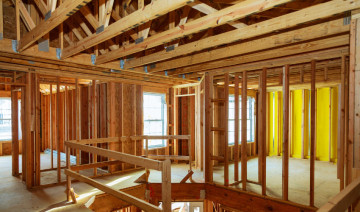
Estimating Wall Framing
Lumber runs roughly 15% to 20% of total house cost — enough that it pays to estimate amounts needed accurately. But don't discount the cost of callbacks due to changes in moisture content. Quality control has the potential to decimate your profit margins.
ESTIMATING PLATE STOCK
Order wall plates in a quantity that’s at least four times the total length of the walls. On walls that run in the same direction as the trusses or joists, an additional plate is needed for drywall backing at the ceiling. More will be needed to cover waste, miscellaneous backing, and continuous fire blocking for walls over 8 ft. high.
ESTIMATING STUDS
For a small house (less than 2,000 sq. ft.) with 16-in. o.c. framing, order 1 stud for each lin. ft. of wall framing — both interior and exterior. For a larger house framed 16 in. o.c., order 1.25 studs for each lin. ft. of wall framing.
ESTIMATING HEADERS
In a house with windows under 36 in. wide, use the following shortcuts:
For solid-sawn headers:
- Count the number of windows and doors; count French doors or sliders as 2;
- Divide by 3 and order that many 10-footers.
For doubled-2x headers:
- Count the number of windows and doors; count French doors or sliders as 2;
- Multiply by 2;
- Divide by 3 and order that many 10-footers.
For extra large or extra narrow windows, calculate headers individually.
ESTIMATING WALL SHEATHING
For rectangular wall areas:
Wall Area = Total Wall Length × Wall Height
Sheathing (4x8 panels) = Wall Area ÷ 32
- Multiply the total length of exterior walls by the wall height to get total wall area;
- Subtract the areas of major openings such as sliders or large windows;
- Divide by 32 (for 4x8 panels).
Remember to account for gable-end walls. For regular gables (same pitch both sides of ridge):
Multiply span by total rise. This gives you the total for two gable-ends.
For irregular gables or single gable-end walls:
- Multiply total run by total rise for each gable end;
- Divide by 32.



